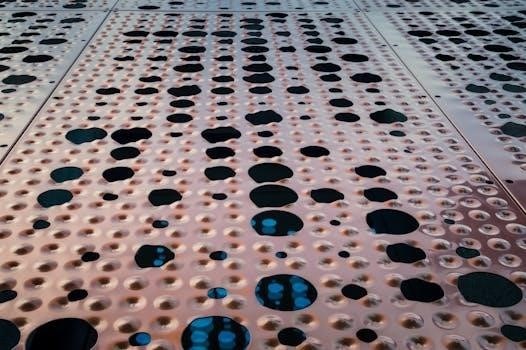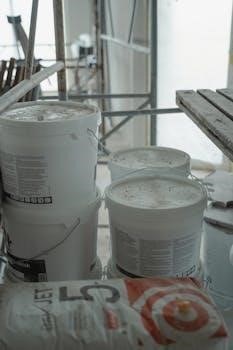Construction Materials List PDF⁚ A Comprehensive Guide
Embark on your construction journey with confidence! Our comprehensive guide offers a detailed and categorized construction materials list in PDF format. Essential for project success‚ it impacts budget‚ timeline‚ and quality. Discover materials from foundation to finishing touches!

Construction materials are the backbone of any building project‚ forming the structures we live‚ work‚ and play in. This guide delves into the world of essential construction materials‚ providing a comprehensive overview and categorized list in a convenient PDF format. Understanding these materials is crucial for effective project planning‚ cost estimation‚ and ensuring the structural integrity of your build;
From the foundational elements like concrete‚ steel‚ and wood to specialized components like roofing materials‚ insulation‚ and finishing materials‚ each plays a unique role in the overall construction process. Choosing the right materials for your specific needs is paramount‚ as it directly impacts the durability‚ safety‚ and aesthetic appeal of the finished product.
This guide aims to equip you with the knowledge necessary to navigate the vast selection of construction materials available. We will explore the properties‚ applications‚ and considerations for each category‚ allowing you to make informed decisions that align with your project goals and budget. By understanding the characteristics of different materials‚ you can optimize your construction process‚ minimize waste‚ and create structures that stand the test of time.
Furthermore‚ we recognize the importance of readily accessible resources. Therefore‚ we provide free PDF templates and resources to aid in your material selection and procurement process. Whether you are a seasoned construction professional or a first-time builder‚ this guide will serve as a valuable reference throughout your project.
Join us as we explore the fascinating world of construction materials‚ empowering you with the knowledge and tools needed to bring your vision to life. Let’s build a solid foundation for your next project!
Importance of a Detailed Materials List
A detailed materials list is the cornerstone of any successful construction project. It serves as a comprehensive inventory of all the components required‚ ensuring that nothing is overlooked during the planning and execution phases; Neglecting to create a thorough materials list can lead to costly delays‚ budget overruns‚ and compromised project quality. This section explores the critical reasons why a detailed materials list is indispensable for construction projects of all sizes.
Firstly‚ a well-defined materials list facilitates accurate cost estimation. By itemizing every material needed‚ you can obtain precise quotes from suppliers‚ enabling you to develop a realistic budget. This prevents unexpected expenses from derailing your project and allows you to make informed decisions about material choices based on cost-effectiveness and performance.
Secondly‚ a detailed materials list streamlines the procurement process. With a clear understanding of the required materials‚ you can efficiently source them from reliable suppliers. This minimizes the risk of material shortages‚ which can halt construction progress and lead to significant delays. Furthermore‚ a comprehensive list allows for bulk purchasing‚ potentially securing discounts and reducing overall project costs.
Thirdly‚ a materials list enhances project coordination and communication. It provides a central reference point for all stakeholders‚ including contractors‚ subcontractors‚ and suppliers. This ensures that everyone is on the same page regarding material specifications‚ quantities‚ and delivery schedules‚ minimizing misunderstandings and errors.
Moreover‚ a detailed materials list contributes to efficient inventory management. By tracking material usage against the list‚ you can monitor consumption‚ identify potential wastage‚ and prevent theft. This helps optimize material utilization‚ reducing unnecessary expenses and promoting sustainable construction practices.
Categorized List of Construction Materials
Organizing construction materials into categories is crucial for efficient planning‚ procurement‚ and management. This section provides a categorized list of essential construction materials‚ offering a structured overview for project stakeholders. The categories are designed to encompass a wide range of materials used in various construction phases‚ from foundational elements to finishing touches.
Concrete and its Components⁚ This category includes all materials related to concrete production and application. Cement‚ the primary binding agent‚ is essential for creating a durable concrete mix. Aggregates‚ such as sand and gravel‚ provide bulk and strength to the concrete. Water is a vital component‚ facilitating the chemical reaction that hardens the concrete. Reinforcement steel (rebars) is added to enhance the tensile strength of concrete structures.
Steel and Reinforcement⁚ This category encompasses various types of steel used for structural support and reinforcement. Structural steel‚ including I-beams and H-beams‚ provides the framework for buildings and bridges. Rebar‚ as mentioned above‚ is used to reinforce concrete elements. Steel mesh is also used for reinforcement‚ particularly in slabs and walls.
Wood and Timber⁚ This category includes both softwood and hardwood lumber used for framing‚ sheathing‚ and finishing. Softwood‚ such as pine and fir‚ is commonly used for structural framing. Hardwood‚ such as oak and maple‚ is often used for flooring‚ cabinetry‚ and decorative elements. Engineered wood products‚ like plywood and OSB‚ provide versatile options for sheathing and subflooring.
Masonry Materials⁚ This category includes bricks‚ blocks‚ and stones used for constructing walls‚ foundations‚ and other structural elements. Bricks‚ made from clay or concrete‚ are a traditional building material. Concrete blocks offer a cost-effective alternative for wall construction. Natural stones‚ such as granite and limestone‚ provide aesthetic appeal and durability.
Other Essential Building Materials⁚ This category encompasses a wide range of materials that don’t fit neatly into the above categories. These include roofing materials (shingles‚ tiles‚ metal roofing)‚ insulation materials (fiberglass‚ foam‚ cellulose)‚ plumbing materials (pipes‚ fittings‚ fixtures)‚ electrical materials (wires‚ cables‚ outlets)‚ and finishing materials (paint‚ drywall‚ flooring).
By categorizing construction materials in this way‚ project managers can gain a clearer understanding of the required resources‚ streamline procurement processes‚ and ensure that all necessary materials are accounted for throughout the construction project. This organized approach contributes to efficient project execution and successful outcomes.
Concrete and its Components
Concrete is a fundamental material in modern construction‚ renowned for its strength‚ durability‚ and versatility. Understanding its components and their roles is crucial for producing high-quality concrete structures. This section delves into the essential components of concrete‚ outlining their properties and importance in achieving desired concrete characteristics.
Cement⁚ Cement is the primary binding agent in concrete‚ responsible for holding the other components together. Portland cement is the most common type‚ manufactured through a process of heating limestone and other materials to form a clinker‚ which is then ground into a fine powder. Different types of Portland cement are available‚ each with specific properties suited for various applications‚ such as rapid hardening‚ sulfate resistance‚ and low heat of hydration.
Aggregates⁚ Aggregates constitute the bulk of the concrete mix‚ providing volume and strength. They are typically divided into two categories⁚ fine aggregates (sand) and coarse aggregates (gravel or crushed stone). The type‚ size‚ and grading of aggregates significantly influence the workability‚ strength‚ and durability of concrete. Proper aggregate selection is essential for achieving the desired concrete properties.
Water⁚ Water is a crucial component‚ initiating the hydration process that allows cement to bind the aggregates together. The amount of water used in the mix‚ known as the water-cement ratio‚ directly affects the strength and workability of the concrete. A lower water-cement ratio generally results in stronger and more durable concrete‚ but it can also reduce workability. Clean‚ potable water is essential for ensuring proper hydration and preventing the introduction of harmful substances into the concrete mix.
Admixtures⁚ Admixtures are chemical compounds added to concrete to modify its properties‚ such as workability‚ setting time‚ strength‚ and durability. Various types of admixtures are available‚ including air-entraining agents (to improve freeze-thaw resistance)‚ water reducers (to increase workability or reduce water content)‚ retarders (to slow down setting time)‚ and accelerators (to speed up setting time). The selection and dosage of admixtures require careful consideration to achieve the desired effects without compromising concrete quality.
Supplementary Cementitious Materials (SCMs)⁚ SCMs are materials used to partially replace Portland cement in concrete mixes‚ offering benefits such as improved durability‚ reduced permeability‚ and lower heat of hydration. Common SCMs include fly ash‚ slag‚ silica fume‚ and metakaolin. The use of SCMs can also contribute to sustainable construction by reducing the environmental impact of cement production.
By carefully selecting and proportioning these components‚ concrete producers can create concrete mixes tailored to meet the specific requirements of each construction project. Understanding the role of each component is essential for ensuring the long-term performance and durability of concrete structures.
Steel and Reinforcement
Steel reinforcement‚ commonly known as rebar‚ plays a vital role in enhancing the tensile strength of concrete structures. Concrete is strong in compression but weak in tension; therefore‚ steel reinforcement is embedded within the concrete to resist tensile forces and prevent cracking. This combination of concrete and steel creates a composite material with exceptional strength and durability‚ capable of withstanding various loads and environmental conditions.

Types of Steel Reinforcement⁚
- Deformed Steel Bars⁚ These are the most common type of rebar‚ featuring a ribbed surface that provides a mechanical bond with the concrete‚ preventing slippage and ensuring effective stress transfer.
- Welded Wire Fabric⁚ This consists of a grid of steel wires welded together‚ used primarily for reinforcing concrete slabs and pavements.
- Steel Fibers⁚ Short‚ randomly distributed steel fibers are added to the concrete mix to improve its toughness and resistance to cracking.
- Epoxy-Coated Rebar⁚ This type of rebar is coated with an epoxy resin to protect it from corrosion‚ particularly in environments exposed to chlorides or other corrosive substances.
- Stainless Steel Rebar⁚ Used in highly corrosive environments where long-term durability is critical‚ stainless steel rebar offers superior corrosion resistance compared to epoxy-coated rebar.
Grades and Sizes of Steel Reinforcement⁚
Steel reinforcement is available in various grades‚ each with different yield strengths and tensile strengths. The grade of rebar is typically indicated by a number representing its minimum yield strength in thousands of pounds per square inch (ksi). Common grades include Grade 40‚ Grade 60‚ and Grade 75. Rebar is also available in various sizes‚ designated by a number that corresponds to the bar’s diameter in eighths of an inch. For example‚ a #4 rebar has a diameter of 1/2 inch.
Applications of Steel Reinforcement⁚
Steel reinforcement is used in a wide range of concrete structures‚ including⁚
- Reinforced Concrete Beams and Columns⁚ Rebar is strategically placed within beams and columns to resist bending and shear forces‚ providing structural support for buildings‚ bridges‚ and other structures.
- Concrete Slabs and Walls⁚ Welded wire fabric or rebar is used to reinforce concrete slabs and walls‚ preventing cracking and enhancing their load-bearing capacity.
- Foundations⁚ Rebar is used to reinforce concrete foundations‚ distributing loads and preventing settlement or cracking.
- Pavements⁚ Steel reinforcement is used in concrete pavements to increase their durability and resistance to cracking under heavy traffic loads.
Proper selection‚ placement‚ and detailing of steel reinforcement are crucial for ensuring the structural integrity and long-term performance of concrete structures. Engineers and contractors must adhere to established codes and standards to ensure that the reinforcement is adequate to resist the anticipated loads and environmental conditions.
Wood and Timber
Wood and timber have been fundamental construction materials for centuries‚ prized for their versatility‚ renewability‚ and aesthetic appeal. From framing houses to crafting intricate finishes‚ wood offers a wide range of applications in modern construction. Understanding the different types of wood‚ their properties‚ and appropriate uses is essential for successful building projects.
Types of Wood⁚
- Softwood⁚ Typically sourced from coniferous trees like pine‚ fir‚ and spruce‚ softwood is known for its workability and affordability. It is commonly used for framing‚ sheathing‚ and interior trim.
- Hardwood⁚ Derived from deciduous trees such as oak‚ maple‚ and cherry‚ hardwood is denser and more durable than softwood. It is often used for flooring‚ furniture‚ and high-end finishes.
- Engineered Wood Products⁚ These materials are manufactured by bonding wood strands‚ fibers‚ or veneers together with adhesives to create composite products with enhanced strength and stability. Examples include plywood‚ oriented strand board (OSB)‚ and laminated veneer lumber (LVL).
Properties of Wood⁚
Wood’s properties vary depending on the species‚ density‚ and moisture content. Key properties to consider include⁚
- Strength⁚ Wood’s ability to resist bending‚ compression‚ and shear forces.
- Stiffness⁚ Wood’s resistance to deformation under load.
- Durability⁚ Wood’s resistance to decay‚ insects‚ and weathering.
- Workability⁚ Wood’s ease of cutting‚ shaping‚ and fastening.
- Dimensional Stability⁚ Wood’s tendency to shrink or swell with changes in moisture content.
Uses of Wood in Construction⁚
Wood is used in a variety of construction applications‚ including⁚
- Framing⁚ Wood studs‚ joists‚ and rafters form the structural skeleton of many buildings.
- Sheathing⁚ Plywood or OSB panels are attached to the framing to provide a surface for exterior cladding.
- Flooring⁚ Wood flooring adds warmth and beauty to interior spaces.
- Trim⁚ Wood trim‚ such as baseboards‚ crown molding‚ and door casings‚ provides decorative accents.
- Exterior Cladding⁚ Wood siding‚ shingles‚ and trim enhance the exterior appearance of buildings.
Sustainable Wood Practices⁚
Using wood from sustainably managed forests helps to ensure the long-term availability of this valuable resource. Look for wood products certified by organizations like the Forest Stewardship Council (FSC) to support responsible forestry practices.
Proper selection‚ treatment‚ and installation of wood are essential for ensuring its durability and performance in construction projects. Consider the specific requirements of the application and choose wood products that are well-suited to the intended use.
Other Essential Building Materials
Beyond the core materials like concrete‚ steel‚ and wood‚ a multitude of other materials play crucial roles in the construction process. These essential building materials contribute to the functionality‚ aesthetics‚ and longevity of structures. A comprehensive understanding of their properties and applications is vital for successful project execution.

Bricks and Masonry Blocks⁚
- Bricks⁚ Made from clay or shale‚ bricks offer durability‚ fire resistance‚ and aesthetic appeal. They are commonly used for walls‚ facades‚ and paving.
- Concrete Blocks⁚ Manufactured from concrete‚ these blocks provide structural support and insulation. They are often used for foundations‚ walls‚ and partitions.
Roofing Materials⁚
- Asphalt Shingles⁚ A popular and affordable roofing option‚ asphalt shingles offer weather protection and come in various styles and colors.
- Tile Roofing⁚ Made from clay or concrete‚ tile roofing provides durability‚ fire resistance‚ and a distinctive appearance.
- Metal Roofing⁚ Known for its longevity and energy efficiency‚ metal roofing is available in various materials like steel‚ aluminum‚ and copper.
Insulation Materials⁚
- Fiberglass Insulation⁚ A widely used insulation material‚ fiberglass is cost-effective and provides good thermal performance.
- Spray Foam Insulation⁚ Expanding to fill gaps and cracks‚ spray foam insulation offers excellent insulation and air sealing properties.
- Rigid Foam Insulation⁚ Available in various types like polystyrene and polyisocyanurate‚ rigid foam insulation provides high thermal resistance.
Windows and Doors⁚
- Windows⁚ Providing natural light and ventilation‚ windows come in various materials like vinyl‚ wood‚ and aluminum.
- Doors⁚ Offering security and access control‚ doors are available in different styles and materials like wood‚ steel‚ and fiberglass.
Plumbing Materials⁚
- Pipes⁚ Used for water supply and drainage‚ pipes are made from materials like copper‚ PVC‚ and PEX.
- Fittings⁚ Connecting pipes and controlling water flow‚ fittings come in various shapes and sizes.
Electrical Materials⁚
- Wiring⁚ Conducting electricity throughout the building‚ wiring comes in various gauges and insulation types.
- Conduits⁚ Protecting wiring from damage‚ conduits are made from materials like metal and PVC.

Finishes and Coatings⁚
- Paint⁚ Providing color and protection‚ paint is available in various types like latex and oil-based.
- Sealants and Adhesives⁚ Sealing gaps and bonding materials‚ sealants and adhesives ensure airtight and watertight construction.
These are just a few of the many essential building materials used in construction. Selecting the right materials for each application is crucial for achieving the desired performance‚ durability‚ and aesthetics of the finished structure.
